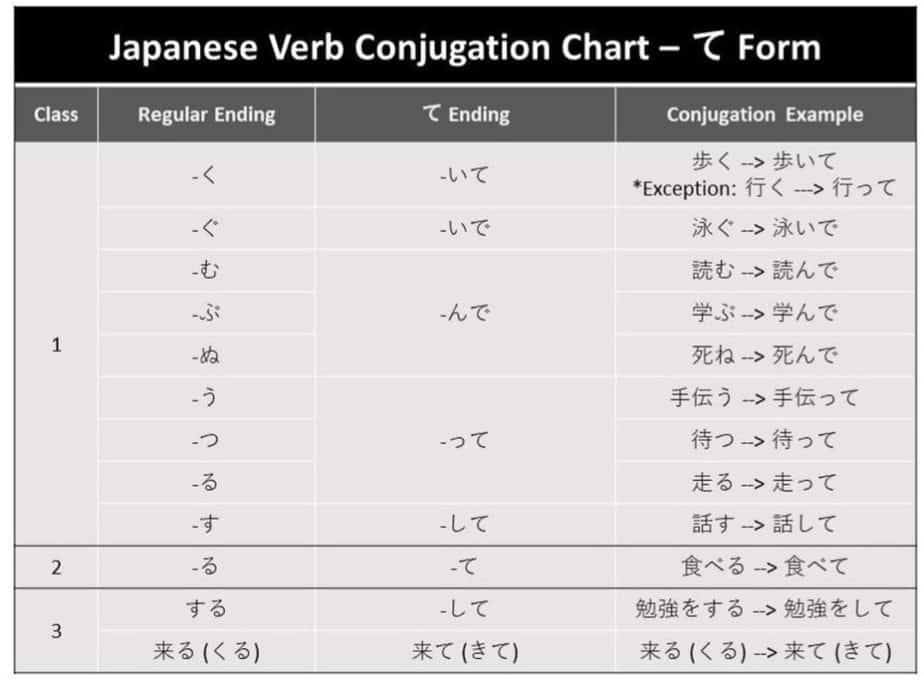Japanese learners will find this blog post useful for gaining a better understanding of Te-form and some of the nuances of communication in Japanese.
Auxiliary words (te) are auxiliary words (setsuzoku joshi) that are used after verbs or adjectives conjugated in the renyoukei form in order to join words. Depending on the context, to convey meaning. て can be transformed into で depending on the grammatical conjugation of the verb or adjective.
Example:
行って (i-t-te)、食べて(ta-be-te)、高くて (taka-ku-te) or
読んで (yo-n-de), 遊んで (aso-n-de), etc.
The te form is required for learning Japanese to make verbs and adjectives easier to comprehend.
An auxiliary て (or te form) is used to describe the relationship between two phrases before and after *. The meanings of the word are:
1.This refers to the sequence of events that occurred before. Continuously occurring,
For example:
1) 昼ごはんを食べて、テレビを見て、寝ました。
I ate lunch, watched TV, and went to bed.
2) デパートに行って、買い物をします。
I go to a department store and do some shopping.
2. Describes something that has a logical basis,
For example:
1) 風邪を引いて、学校を休んだ。
I caught a cold and was absent from school.
3. Explains things that have harmony in their meaning
For example:
1) この家が古くて、汚いです。
This house is old and messy.
2)この車が新しくて、高いです。
This car is new and expensive.
When two adjectives have conflicting meanings, the te form should not be used.
4.Refers to procedures or methods such as
For example:
1) 毎日歩いて、会社に行きます。
I walk every day and go to work.
5. Refers to the start of time, or a particular time period in the past,
For example:
1) 会社で働いて、5年間になりました。
I have been working for a company for 5 years.
What is the TE form of verbs?
We will conjugate group 1, 2, 3 verbs from the table below using the て (te) form.
In this lesson, we’ll look at the て form. In today’s lesson, we will study type 1, that is, we will divert from dict form to てform, everyone knows already) let’s get started.
V. Group 1
Let’s begin with action group 1. The first thing we need to know is that each verb has a last sound or hiragana. Is that what it ends with? Based on the following table, divide into groups.
After we have identified each group of verbs, we can convert the word form Dict into て form.
After we separate the verb groups, this method is used to come up with one verb. Follow these steps. (In Japanese, there are three groups of medicinal verbs, so let’s see if they’re from group 1, group 2, or group 3.)
1. This is the last character of the verb in hiragana. The rectangular frame corresponds to this
For example, the word 泳ぐ「およぐ」swim. The last hiragana of a word
Ends with ぐ corresponding to the letter いで in the square frame.
2 Cut off the last hiragana of the verb, and place the cut-off word instead of the last hiragana of the verb, following the rules for group 1 verbs.
For example, the verb 書く「かく」means to write with いて in a square. Therefore, when converting to form て form, it will be
いて becomes 書いて
That is, omitting く and adding いて, 書く becomes 書いて, etc.
Anyone can practice conjugating the て form verb from the example we use in the picture below. Why did 待つ become 待って?
What has changed? You will have to read what we said throughout the diversion again. Following these steps will help.
You can see it in the example below. Everyone will see a star shape on the word 行く「いく」Words like this are exceptions.exception.
When conjugating this verb, remember that After the く is cut off, just add って to the end.
vocabulary
待つ「まつ」 means waiting.
会う「あう」means to meet, to meet
降る「ふる」means to fall and is used for rain and snow.
飲む「のむ」means to drink
話す「はなす」means to talk.
聞く「きく」means to listen or ask.
泳ぐ「およぐ」means to swim
行く「いく」means to go
V. Group 2
Next, let’s look at the second group of verbs. A hiragana character represents each of these verbs. There will be a repeating pattern of ending words withる ru. Right, in the first group of verbs? Although group 2 verbs have the same る ru, there are only a few in group 2. It’s important to remember what is there. Since the rest of the verbs will be in the first category.
Second group of verbs are those with a sound ending in いる and える (must be a sound, not letters).
For example,
the word 見せる みせる means to see .
This * has a sound ending in *, so it falls under the second group of verbs, since the * is pronounced as a vowel.
You can easily conjugate the second group of verbs, Minna-san, just cut off the * and replace it with *. The following picture might help you understand (if you still don’t understand, please see the picture below).
V. Group 3
The last group of verbs, the third group of verbs, consists of only two verbs, する and くる so remember how they differ.
する means to do, change the time to change する to して
くる means come, when you change, change くる to きて
We can do a little more than that. There are only a few minutes left. Hehe. Verbs that are nouns will also be included in this third group of verbs. A symptom verb is created by taking a noun and turning it into a verb by adding +する.
勉強 「べんきょう」means to study. When adding する , it becomes 勉強する means to study
テニス means tennis. When adding
する it becomes テニスする means to play tennis,
Te -Form Chart
